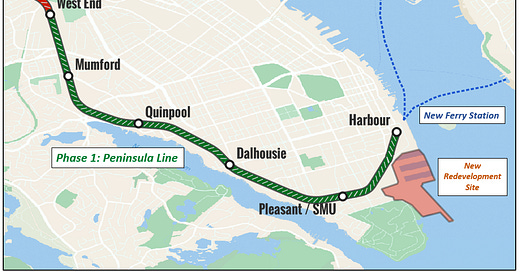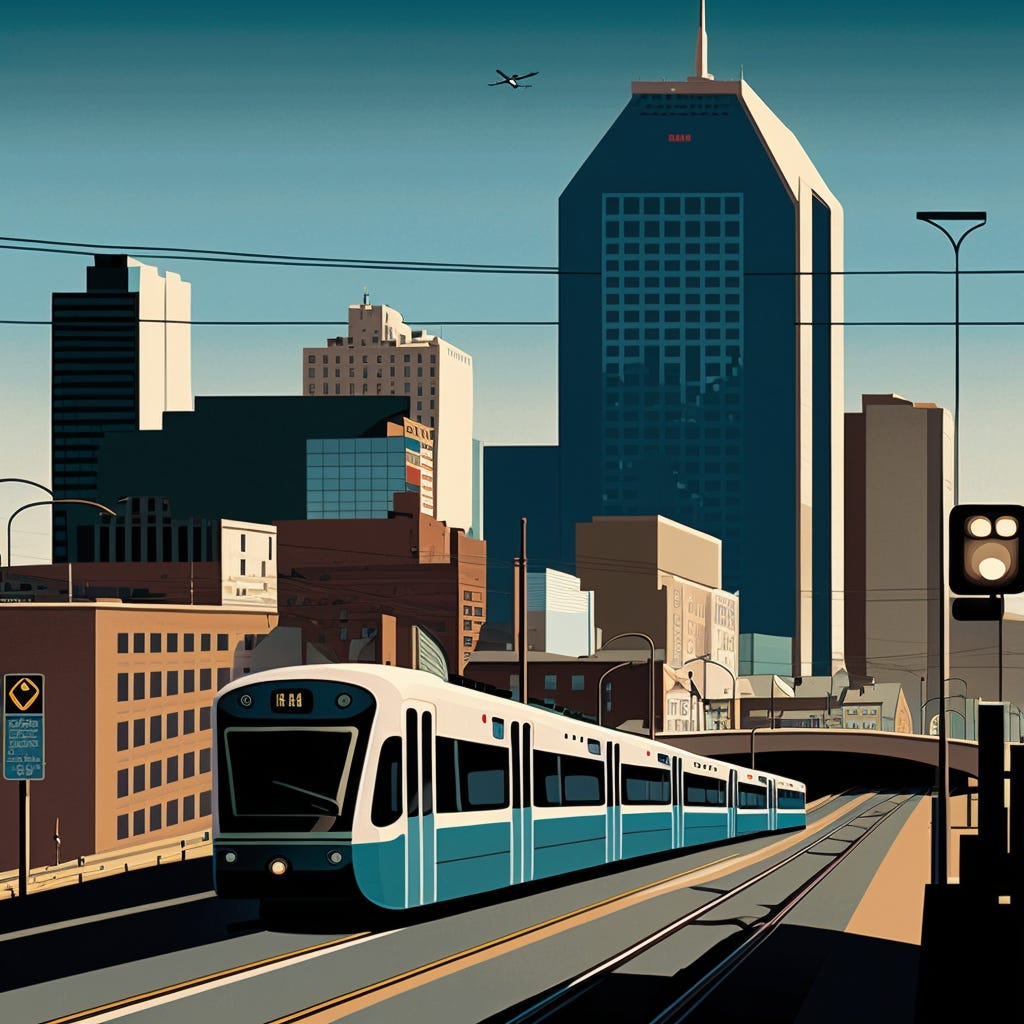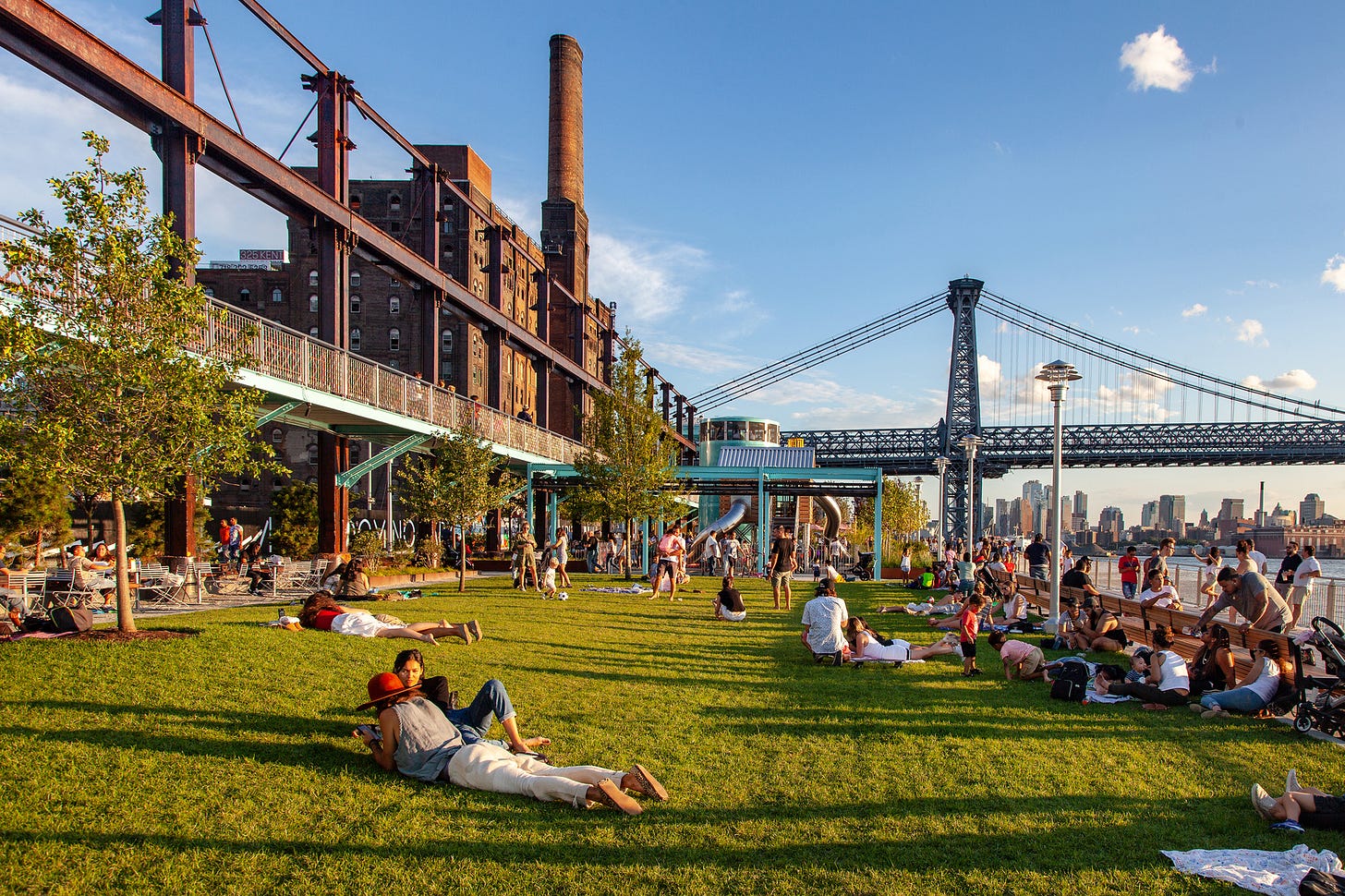Imagining a Future Halifax Transit System
We should use buses more and better, but we don't. So let's start planning how to use the only rail line in Halifax.
Of my posts so far, this probably the most out there. I’m gonna be throwing a lot of ideas around, with not much data to support it. But, luckily for me, transportation can be pretty simple. Complex models are often weaker than simple models, and a good map and clear story go a long way.
So here’s my story about how to build a lasting public transportation system in Halifax. Scroll down if you just want to see the idea.
5 Principles for a “Transit Highway” in Halifax:
It’s time. Halifax is growing rapidly, and is one of the fastest growing cities in Canada, adding 20,000 residents last year alone. Even if the current pace slows, the province’s target of 2M by 2060 implies that Halifax becomes a city of a million residents within 40 years. The leap from 500k to 1 million is a fine time to get serious about public transport. Calgary’s initial “CTrain'“ system started operating in 1981, when it had a population of 580k. I’ve lived in Calgary, its a much better city to navigate by car than Halifax, with high-capacity roads that Halifax - as an older city - doesn’t have (like it or not!). We need to offer transport options that scale easier than roads as we double the population in the next few decades.
Functional public transit needs its own right of way. Zipping by congested roads is the best way to convince more people to use public transit. This could be done by giving buses exclusive rights to existing roads, but Halifax isn’t ready for that (see the Spring Garden failure). Building new infrastructure exclusively for public transit is better politically. That’s why I’m going to ignore road-based plans, even though Halifax has a ready-to-go BRT plan that is a clear improvement.
Building “greenfield” (new) rail infrastructure isn’t happening. There are countries that can deliver rail projects at low cost. We aren’t those countries. We aren’t going to build a brand new urban rail system. There is no appetite to raise taxes to fund a real subway either. Toronto should (re-)learn how to build subways, Halifax needs to look at what pieces it’s got laying around.
Converting freight rail is the least disruptive way. Freight railroads are great businesses, and critical infrastructure. But that doesn’t mean they should be operating their tracks throughout a good chunk of the peninsula. Railroaders are always nervous about giving up track, especially port-access track, but there is a deal to be made here. Turning industrial ports into a new waterfront community with terrific transit options is a win-win if you can get everyone on board (big if!). As complicated as managing the shift of large industrial customers would be, it is simpler than building new rail, and less politically toxic than turning off roads for cars.
I think it’d be sweet! Halifax is an awesome city, and we should be excited about growth because we can do new things. I’ve been in New York City for the past few weeks, which has many amazing industrial conversions projects (e.g., the high line, Hudson Yards, Domino Park and Sugar Refinery).
I think this needs to be a multipart series. But lets cut to (something like) the end goal for fun.
The Peninsula Line
So what’s the plan? Phase 1, a “Peninsula Line” (shown in green) might go something like this:
Buy out CN and arrange for its customers in the Halterm port area (container terminals and a grain elevator) to move elsewhere in the Harbour. It’s not simple, but nobody would put such an industrial operation there today either (trucks from Halterm currently drive across downtown). I think I’ll do a full post just on this transition.
Build a handful of simple stations. The track is already there, so if you keep the stations modest you can accelerate the timelines and keep cost low.
Run new or redirect ferry services to connect to the ‘Harbour’ station, to maximize the usefulness of the line for trips to/from Dartmouth. Overall, the idea as I see has a real weakness in not offering enough for Dartmouth, so efficient ferry connections are pretty key
With the newly-vacated industrial port area, the city could masterplan a new waterfront community. It’d be prime real estate, with amazing transit options, a great place for thousands of young people and university students to live and work. The city, as coordinator, would be capturing the land value appreciation, which could partially offset the big investment needed in the trains and stations. Finally, Halifax’s lower harbourfront is weird right now, more people living near pier 21 would help businesses and the vibes1.
Bus services would be re-oriented around funneling rider onto / from the train line. Collecting as many trips as possible on this “transit highway” is the goal, since more ridership makes public transit better, not worse.
Big, beautiful, (free) parkades at the outer stations, which I’m calling Mumford and West End, would allow suburban families to easily park and ride into the city. No more fussing about parking, or sitting in traffic.
Those pieces would give Halifax some really interesting transit options, especially within the Peninsula, which is densifying right now. A (I think trickier) Phase 2 could be to similarly shift CN customers in the North End, which would free up the track all along the Bedford Basin (shown in red). Running express trains along the clogged Bedford Highway to the Waterfront might be my Holy Grail of transit in Halifax.
Having a station closer to the Citadel and North End would also be ideal, but the idea here was to play with the tools available. Maybe when the city has real transit, there will be enough political support for expanding it even more.
I tweeted out a map of the “Peninsula Line” and got a lot of responses, with many people referencing HRM’s commuter train study (of sharing track with CN) or other reasons why this wouldn’t work (like single-track stretches - that would be a technical challenge to sort out). But fundamentally, there is no perfect transit plan. To steal a line from politics:
Don’t compare me to God, compare me to the alternative.
The alternative, of adding another Halifax of cars on top of Halifax today, doesn’t sound too good either.
Hey there,
If you've been enjoying my Substack, first of all, thank you! You're awesome. But, did you know that subscribing can also make me look awesome to the algorithm gods? It's true! The more subscribers I have, the more my content gets recommended to others. So, if you want to help boost my ego and make sure you never miss out on my musings, hit that subscribe button.
Thanks a bunch,
Deny
The Downtown Halifax Business Commission has complained that not enough workers are coming back to the office. Adding thousands of new residents seems like a good way of helping businesses downtown.







